Adhesion Performance and Recovery of Acrylic PSA with Acrylic Elastomer (AE) Blends via Thermal Crosslinking for Application in Flexible Displays
Abstract
:1. Introduction
2. Experimental Section
2.1. Materials
2.2. Non-Crosslinked Acrylic PSA/AE Blends
2.3. Thermal Crosslinked Acrylic PSA/AE Blends
2.4. Characterizations
3. Results and Discussion
3.1. Basic Properties of Acrylic PSA and AE
3.2. Non-Crosslinked Acrylic PSA/AE Blends
3.3. Thermally Crosslinked Acrylic PSA/AE Blends
4. Conclusions
Author Contributions
Funding
Conflicts of Interest
References
- Satas, D. Pressure sensitive adhesives and adhesive products in the United States. In Handbook of Pressure-Sensitive Adhesive Technology, 3rd ed.; Satas, D., Ed.; Van Nostrand-Reinhold: New York, NY, USA, 1999; Volume 1, pp. 1–21. [Google Scholar]
- Bae, K.-Y.; Lim, D.-H.; Park, J.-W.; Kim, J.-J.; Jeong, H.-M.; Takemura, A. Adhesion performance and surface characteristics of low surface energy PSAs fluorinated by UV polymerization. Polym. Eng. Sci. 2013, 53, 1968–1978. [Google Scholar] [CrossRef]
- Kim, P.-S.; Lee, S.-W.; Park, J.-W.; Park, C.-H.; Kim, H.-J. Kinetic and characterization of UV-curable silicone urethane methacrylate in semi-IPN-structured acrylic PSAs. J. Adhes. Sci. Technol. 2013, 27, 1866–1872. [Google Scholar] [CrossRef]
- De, S.K.; White, J.R. Rubber Technologists’s Handbook, 1st ed.; Rapra Technology Limited: Shropshire, UK, 2001; Volume 1. [Google Scholar]
- Hesami, M.; Jalali-Arani, A. Investigation of miscibility and phase structure of a novel blend of poly(lactic acid) (PLA)/acrylic rubber (ACM) and its nanocomposite with nanosilica. J. Appl. Polym. Sci. 2017, 134, 45499. [Google Scholar] [CrossRef]
- Jha, A.; Dutta, B.; Bhownick, A.K. Effect of fillers and plasticizers on the performance of novel heat and oil-resistant thermoplastic elastomers from nylon-6 and acrylate rubber blends. J. Appl. Polym. Sci. 1999, 74, 1490–1501. [Google Scholar] [CrossRef]
- Jha, A.; Bhownick, A.K. Thermal degradation and ageing behaviour of novel thermoplastic elastomeric nylon-6/acrylate rubber reactive blends. Polym. Degrad. Stab. 1998, 62, 575–586. [Google Scholar] [CrossRef]
- Ding, X.; Xu, R.; Yu, D.; Chen, H.; Fan, R. Effect of ultrafine, fully vulcanized acrylate powdered rubber on the mechanical properties and crystallization behavior of nylon 6. J. Appl. Polym. Sci. 2003, 90, 3503–3511. [Google Scholar] [CrossRef]
- Abolhasani, M.M.; Jalali-Arani, A.; Nazockdast, H.; Guo, Q. Poly (vinylidene fluoride)-acrylic rubber partially miscible blends: Crystallization within conjugated phases induce dual lamellar crystalline structure. Polymer 2013, 54, 4686–4701. [Google Scholar] [CrossRef]
- Abolhasani, M.M.; Guo, Q.; Jalali-Arani, A.; Nazockdast, H. Poly (vinylidene fluoride)–acrylic rubber partially miscible blends: Phase behavior and its effects on the mechanical properties. J. Appl. Polym. Sci. 2013, 130, 1247–1258. [Google Scholar] [CrossRef]
- Wong-On, J.; Wootthikanokkhan, J. Dynamic vulcanization of acrylic rubber-blended PVC. J. Appl. Polym. Sci. 2003, 88, 2657–2663. [Google Scholar] [CrossRef]
- Shivakumar, E.; Srivastava, R.B.; Pandey, K.N.; Das, C.K. Compatibility study of blends of acrylic rubber (ACM), poly (ethyleneterephalate) (PET), and liquid crystalline polymer (LCP). J. Macromol. Sci. Part A 2005, 42, 1181–1195. [Google Scholar] [CrossRef]
- Wu, C.; Otani, Y.; Namiki, N.; Emi, H.; Nitta, K.-H. Phase modification of acrylate rubber/chlorinated polypropylene blends by a hindered phenol compound. Polym. J. 2001, 33, 322–329. [Google Scholar] [CrossRef]
- Lee, J.-H.; Lee, T.-H.; Shim, K.-S.; Park, J.-W.; Kim, H.-J.; Kim, Y.; Jung, S. Effect of crosslinking density on adhesion performance and flexibility properties of acrylic pressure sensitive adhesives for flexible display applications. Int. J. Adhes. Adhes. 2017, 74, 137–143. [Google Scholar] [CrossRef]
- Lee, J.-H.; Shim, G.-S.; Park, J.-W.; Kim, H.-J.; Kim, Y. Adhesion performance and recovery of acrylic pressure-sensitive adhesives thermally crosslinked with styrene-isoprene-styrene elastomer blends for flexible display applications. J. Ind. Eng. Chem. 2019, 78, 461–467. [Google Scholar] [CrossRef]
- Lee, J.-H.; Lee, T.-H.; Shim, K.-S.; Park, J.-W.; Kim, H.-J.; Kim, Y.; Jung, S. Molecular weight and crosslinking on the adhesion performance and flexibility of acrylic PSAs. J. Adhes. Sci. Technol. 2016, 30, 2316–2328. [Google Scholar] [CrossRef]
- Park, C.-H.; Lee, S.-J.; Lee, T.-H.; Kim, H.-J. Characterization of an acrylic polymer under hygrothermal aging as an optically clear adhesive for touch screen panels. Int. J. Adhes. Adhes. 2015, 63, 137–144. [Google Scholar] [CrossRef]
- Dale, W.C.; Paster, M.D.; Haynes, J.K. Mechanical property-performance relations of acrylic pressure sensitive adhesives. In Advances in Pressure Sensitive Adhesive Technology; Satas, D., Ed.; Satas & Associates: Warwick, UK, 1995; pp. 65–111. [Google Scholar]

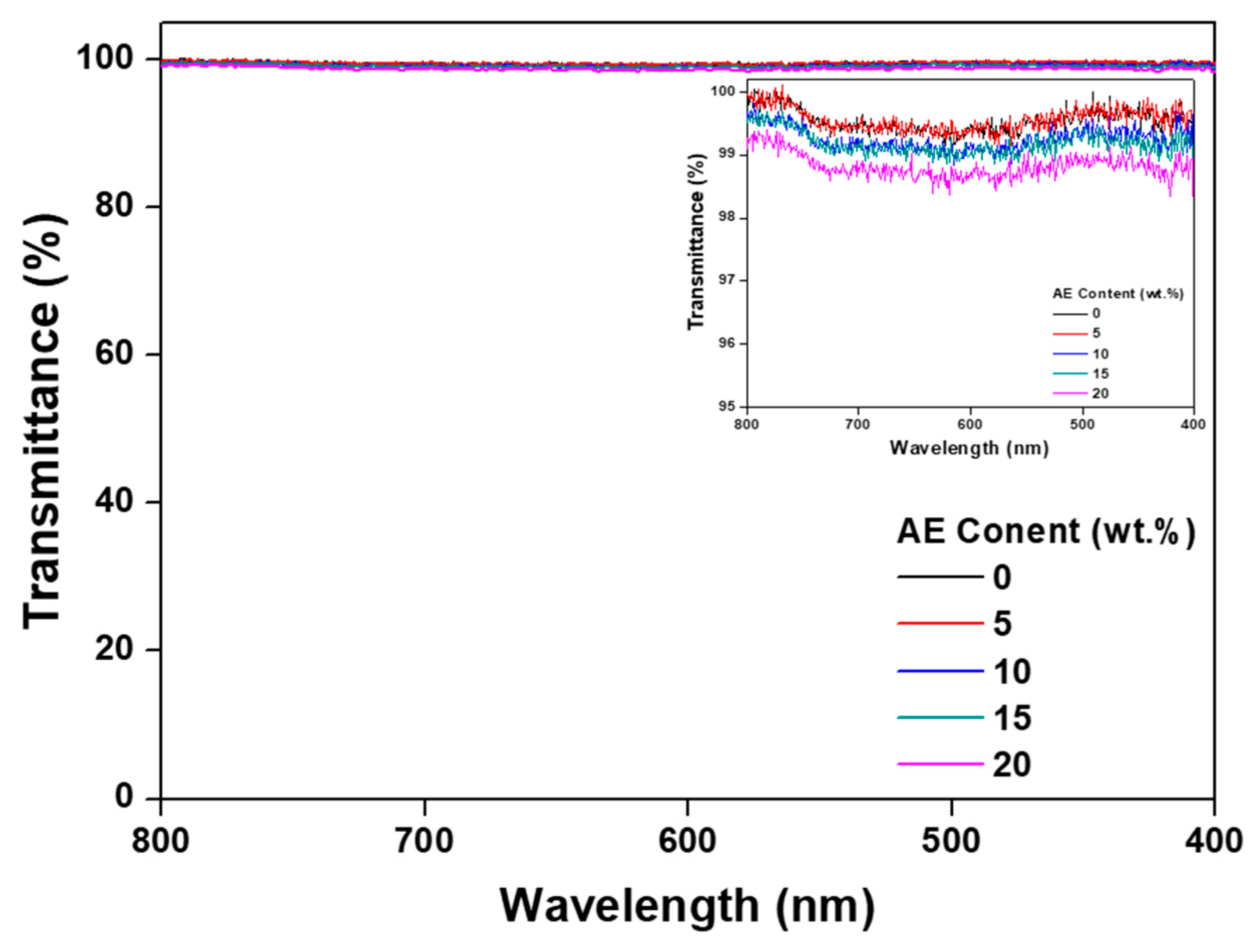
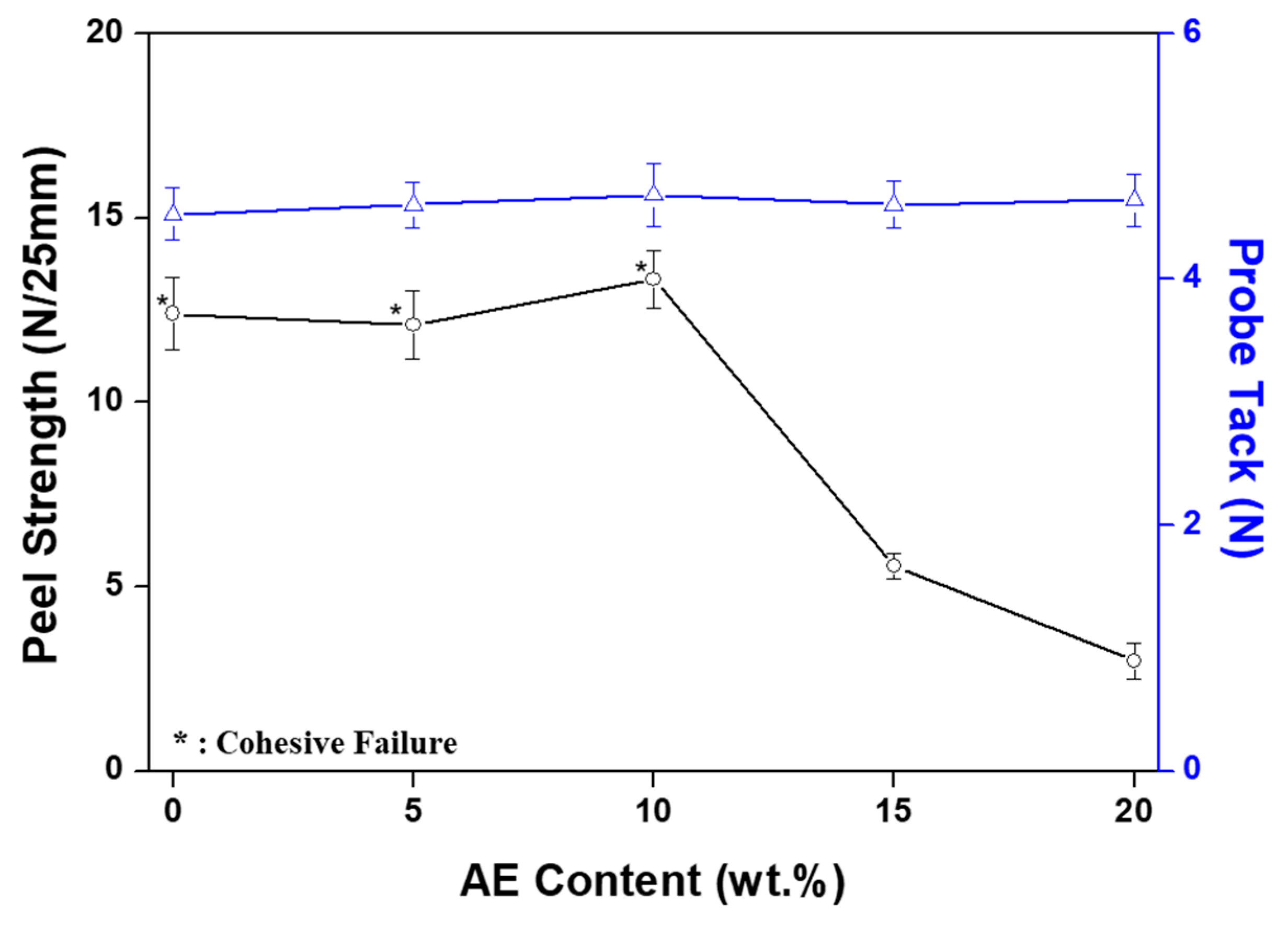
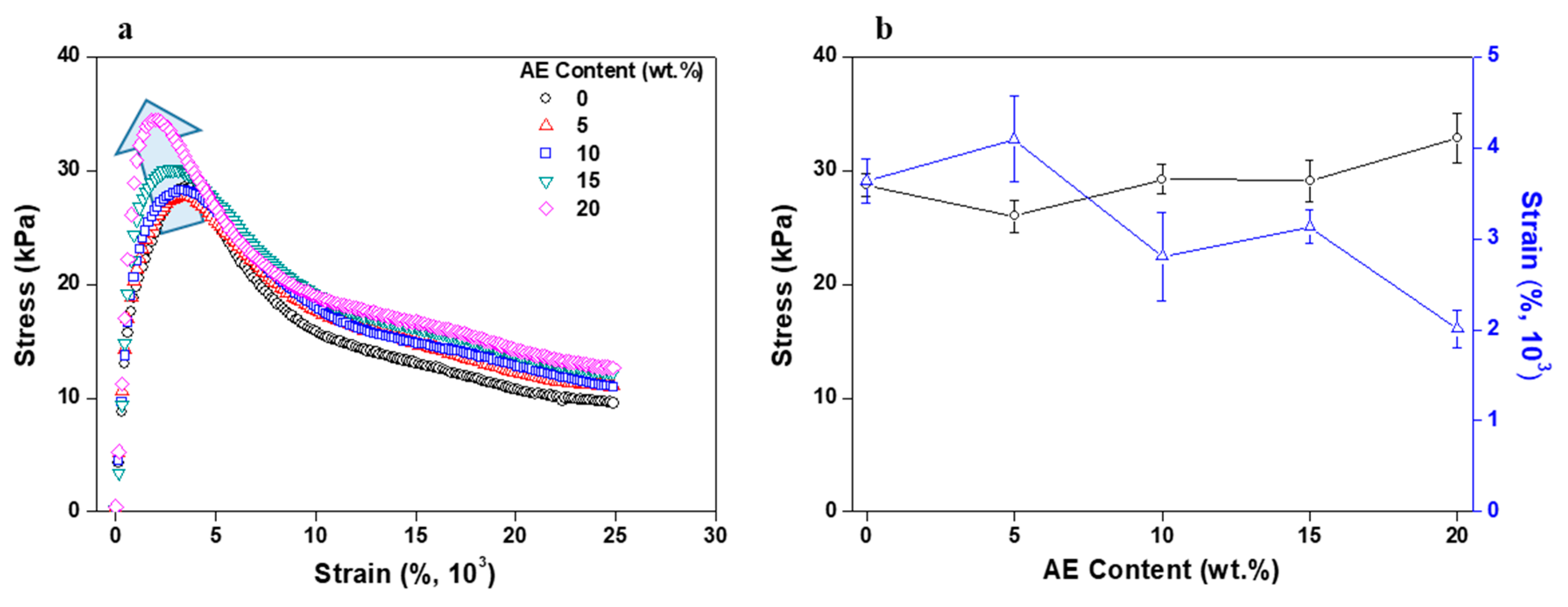
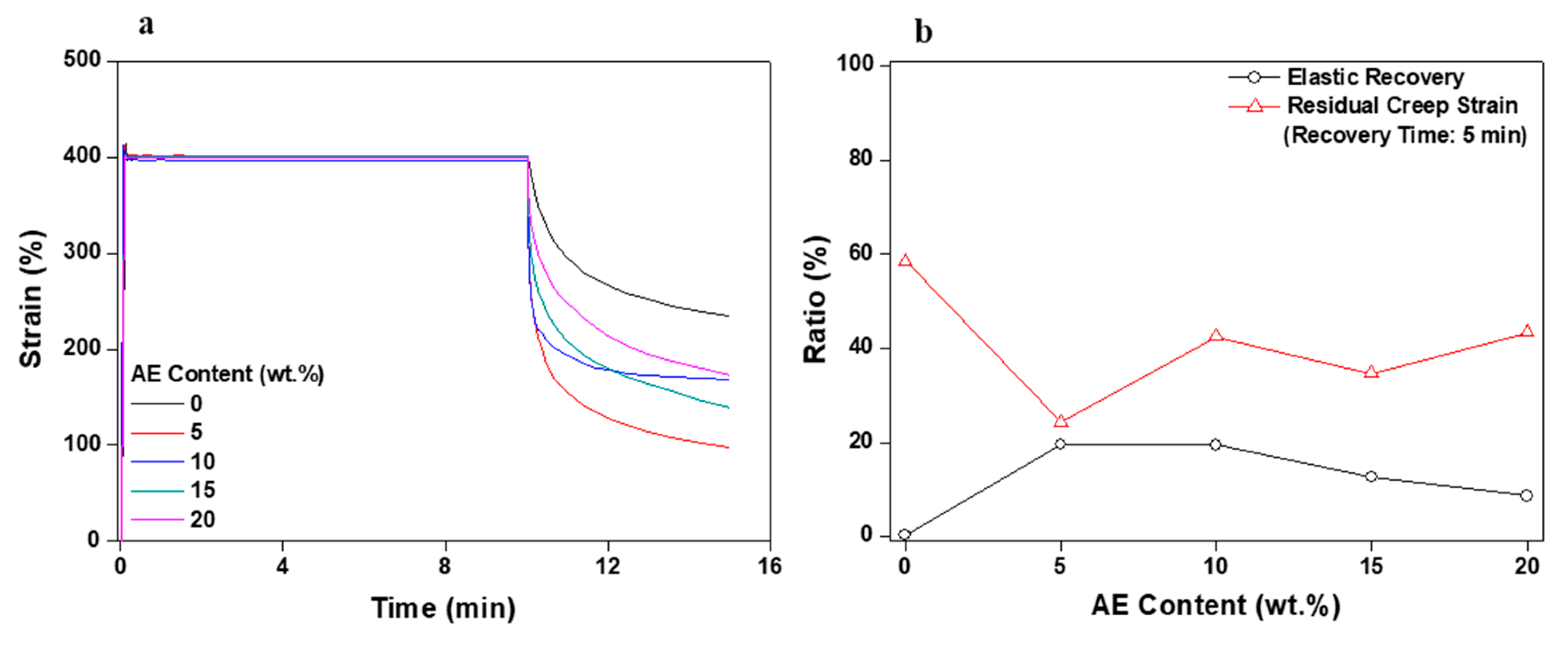
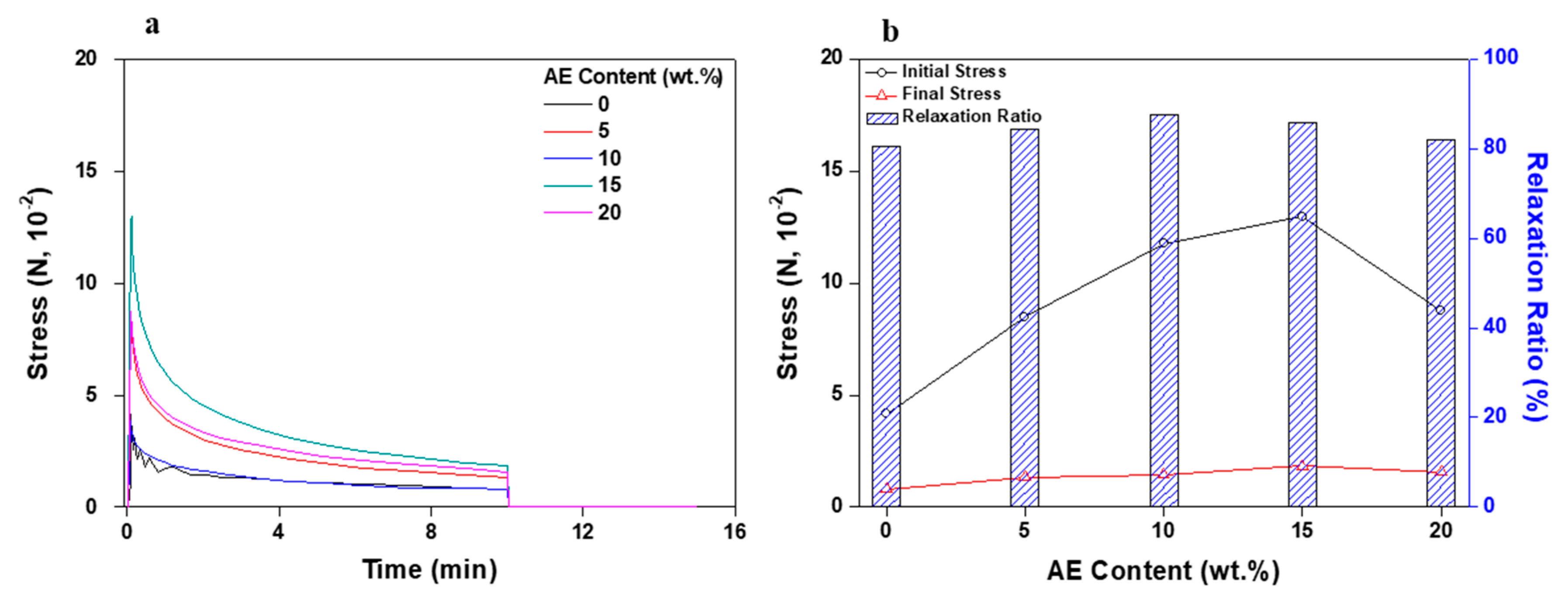
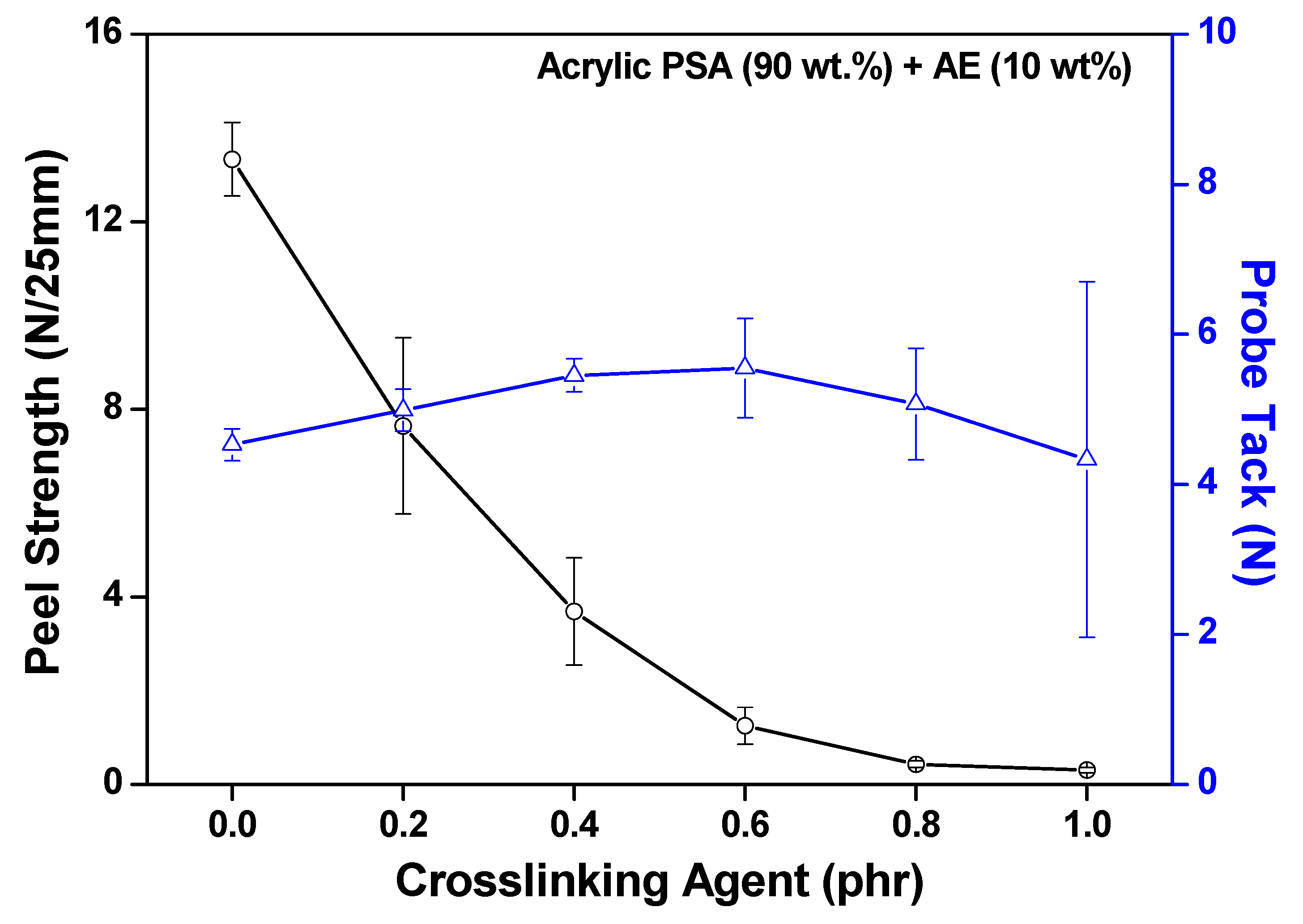
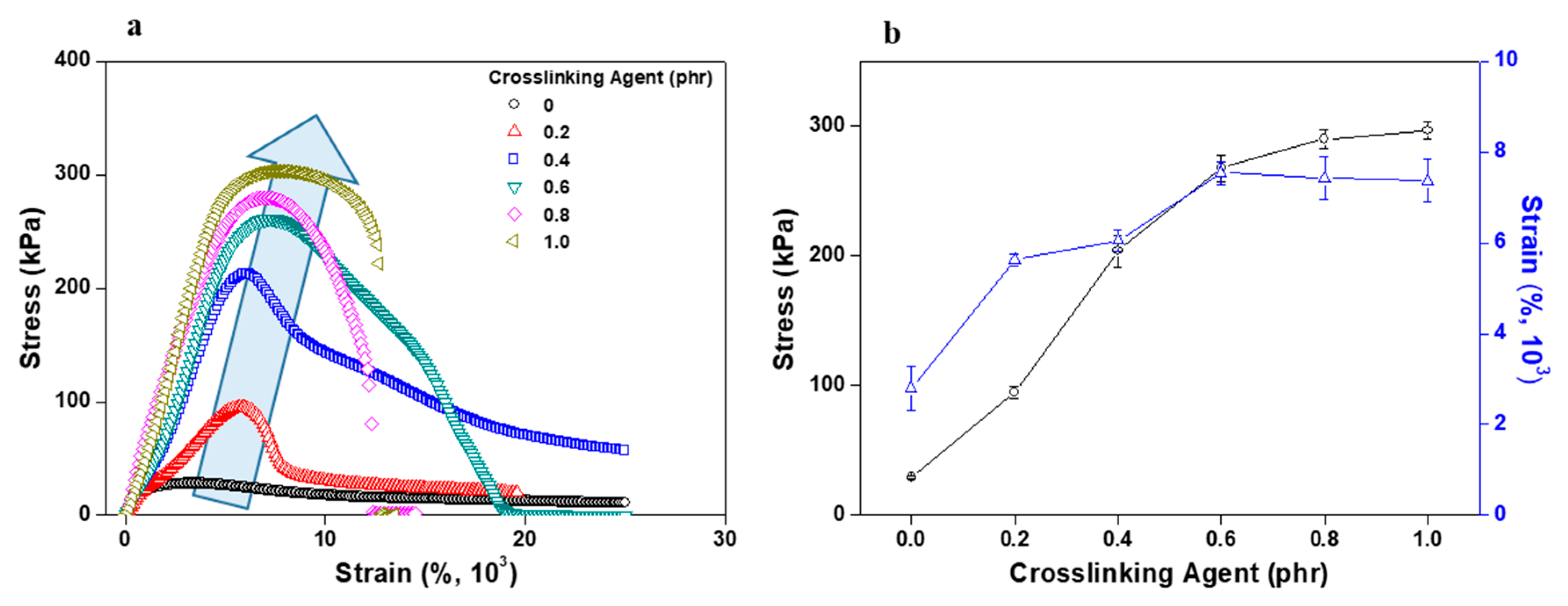
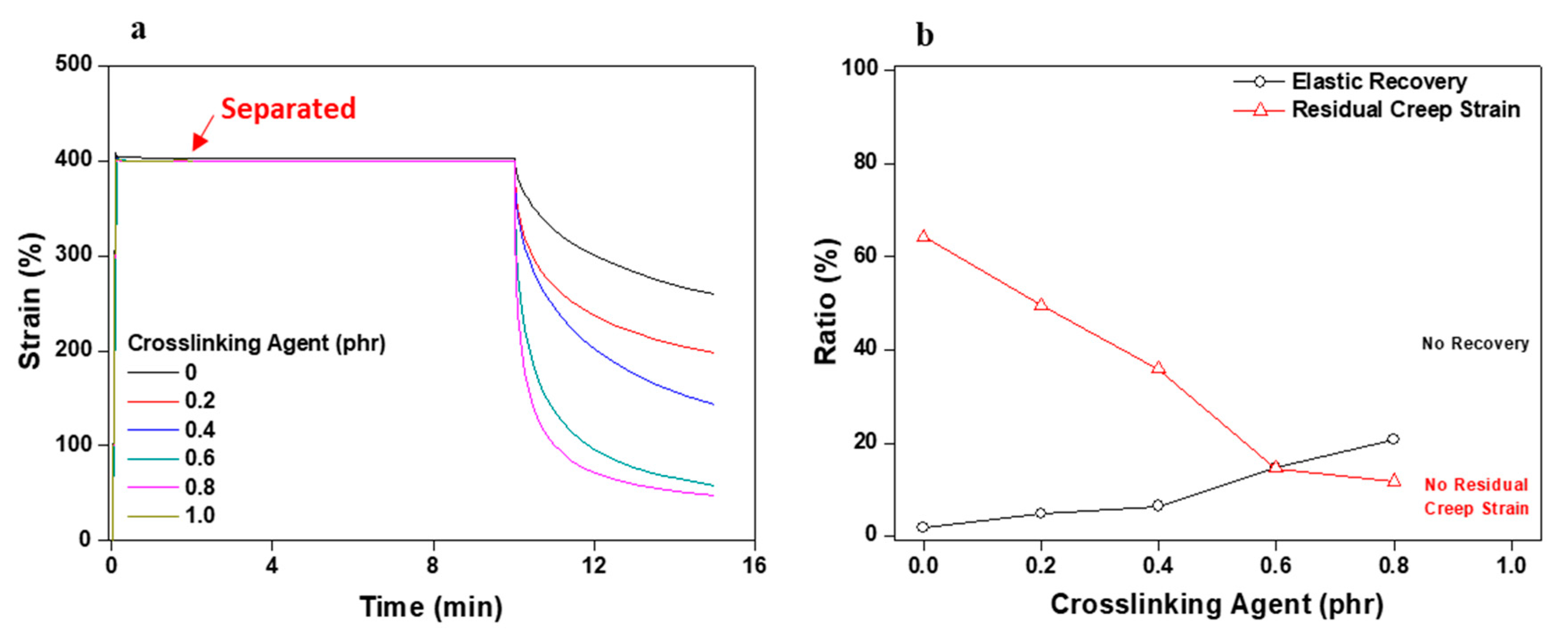
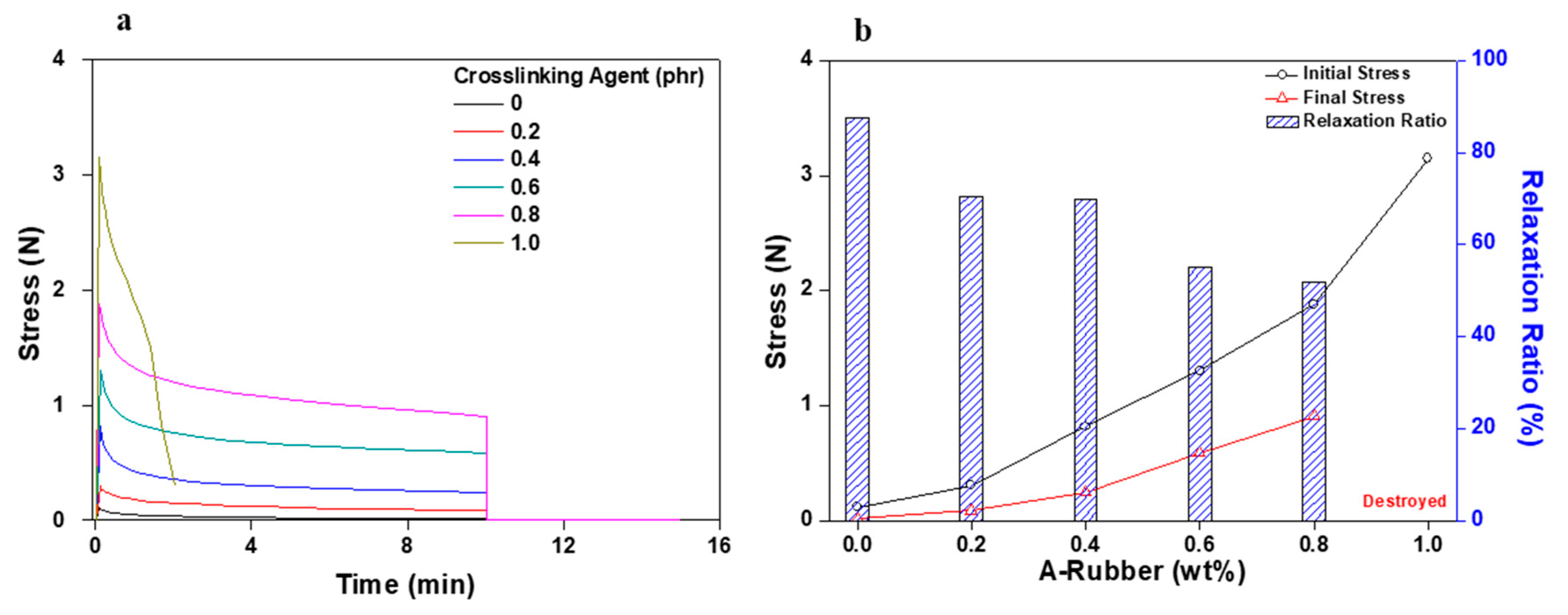

| Materials | Mn (g/mol) * | Mw (g/mol) * | PDI * | Tg (°C) ** |
|---|---|---|---|---|
| Acrylic PSA prepolymer | 24,375 | 50,670 | 2.1 | −40 |
| Acrylic elastomer | 342,750 | 1,167,800 | 3.4 | −30 |
| Samples | Acrylic PSA Prepolymer (wt %) | Acrylic Elastomer (wt %) |
|---|---|---|
| PSA-AE-00 | 100 | 0 |
| PSA-AE-05 | 95 | 5 |
| PSA-AE-10 | 90 | 10 |
| PSA-AE-15 | 85 | 15 |
| PSA-AE-20 | 80 | 20 |
| Samples | Crosslinked Acrylic PSAs | AE (wt %) | |
|---|---|---|---|
| Acrylic PSA Prepolymer (wt %) | Crosslinking Agent (phr) | ||
| PSA-AE-10-00 | 90 | 0 | 10 |
| PSA-AE-10-02 | 0.2 | ||
| PSA-AE-10-04 | 0.4 | ||
| PSA-AE-10-06 | 0.6 | ||
| PSA-AE-10-08 | 0.8 | ||
| PSA-AE-10-10 | 1.0 | ||
© 2019 by the authors. Licensee MDPI, Basel, Switzerland. This article is an open access article distributed under the terms and conditions of the Creative Commons Attribution (CC BY) license (http://creativecommons.org/licenses/by/4.0/).
Share and Cite
Lee, J.-H.; Shim, G.-S.; Kim, H.-J.; Kim, Y. Adhesion Performance and Recovery of Acrylic PSA with Acrylic Elastomer (AE) Blends via Thermal Crosslinking for Application in Flexible Displays. Polymers 2019, 11, 1959. https://doi.org/10.3390/polym11121959
Lee J-H, Shim G-S, Kim H-J, Kim Y. Adhesion Performance and Recovery of Acrylic PSA with Acrylic Elastomer (AE) Blends via Thermal Crosslinking for Application in Flexible Displays. Polymers. 2019; 11(12):1959. https://doi.org/10.3390/polym11121959
Chicago/Turabian StyleLee, Jung-Hun, Gyu-Seong Shim, Hyun-Joong Kim, and Youngdo Kim. 2019. "Adhesion Performance and Recovery of Acrylic PSA with Acrylic Elastomer (AE) Blends via Thermal Crosslinking for Application in Flexible Displays" Polymers 11, no. 12: 1959. https://doi.org/10.3390/polym11121959
APA StyleLee, J.-H., Shim, G.-S., Kim, H.-J., & Kim, Y. (2019). Adhesion Performance and Recovery of Acrylic PSA with Acrylic Elastomer (AE) Blends via Thermal Crosslinking for Application in Flexible Displays. Polymers, 11(12), 1959. https://doi.org/10.3390/polym11121959






